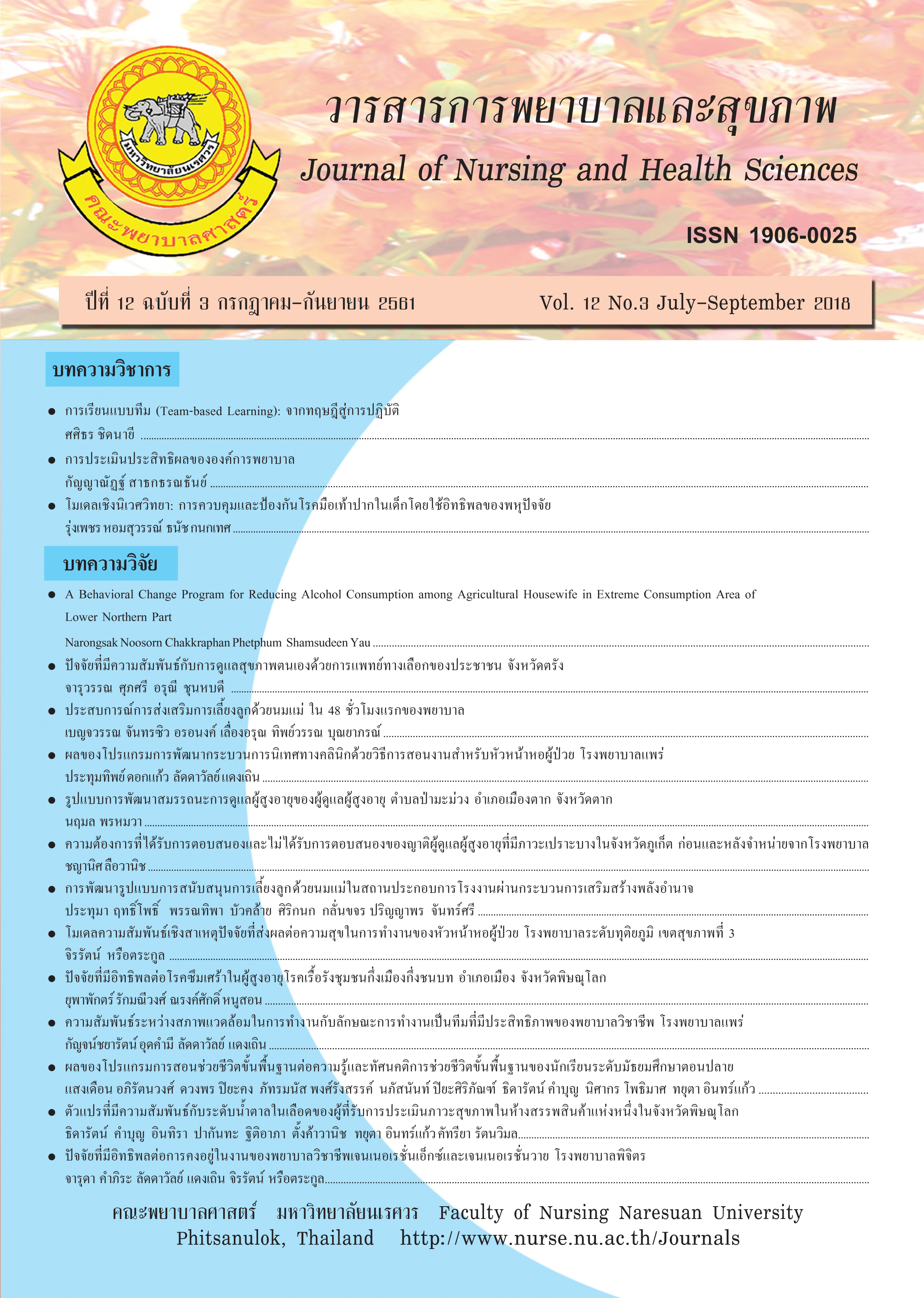Factors Related toSelf-Care with Alternative Medicine Used among Trang People
Main Article Content
Abstract
The alternative medicine nowadays becomes one of the significant healthcare options among Trang people. The studies regarding the use of alternative medicine (AM) among this population arerarely and conducted and unclear. Therefore, the purposes of this research were to study self-care behaviors among these people who were using AMsand to identify factors that may relate to this phenomenon. Three hundred and eighty-one participants of this study were selected with purposive sampling technique with the inclusive criteriasuch as aged between 30-60 years old and usedthe AMfor at least one year. Researchers developed a questionnaire for collecting data that has shown good internal consistency reliability with Cronbach's alphas equal to .73. Descriptive statistics, Chi-square, and Spearman's rank correlation were used to analyze data. The study found that the frequency of using AM by participants were sometime (less than three times per week). The majority of AM using by participants werea chant or prayer (99%), herbal drinking (97.4%), and herbal consumption (97.1%), respectively. By contrast, most of the participants never used Thai hermit exercise (90.3%) and Thai herbal body scrub (82.2%). The relationship analysis result found thatgenderas the predisposing factor had a significant association with the use of AM in medium level (Cramer's V = .381, p < .01); while, educational level (Cramer's V = .242, p < .01), occupation (Crammer's V = .234) andpresent health status (Cramer's V = .230, p < .01) had significant relationships with the use of AM in low level. Moreover, knowledge of AM (Spearman's Rho = .255, p < .01) and the perceived benefit of AM (Spearman's Rho= .104, p < .05) were significant predisposing factors.
Article Details
References
กับพฤติกรรมการดูแลสุขภาพตนเองด้วยการ
แพทย์แผนไทยของบุคลากรมหาวิทยาลัยราชภัฏ
สวนสุนันทา.กรุงเทพมหานคร: มหาวิทยาลัย
ราชภัฏสวนสุนันทาสถาบันวิจัยและพัฒนา.
ปทิตตา จารุวรรณชัย และกฤช จรินโท. (2558).
คุณลักษณะของผู้ใช้การแพทย์ทางเลือกใน
โรงพยาบาลของรัฐ. วารสารบัณฑิตศึกษา
มหาวิทยาลัยราชภัฏวไลยอลงกรณ์ในพระบรม
ราชูปถัมภ์, 9(2), 73-84.
เพ็ญจันทร์ ประดับมุข-เซอร์เรอร์ และพีระพงศ์
วงศ์อุปราช. (2553). การศึกษาพฤติกรรมการใช้
การแพทย์ ทางเลือกของคนไทย. ในสำนักงาน
ข้อมูลและคลังความรู้กรมการแพทย์แผนไทย
และการแพทย์ทางเลือก กระทรวงสาธารณสุข.
รายงานสถานการณ์การแพทย์แผนไทย
การแพทย์พื้นบ้าน และ การแพทย์ทางเลือก
ประจำปี 2550-2552 (หน้า 69-82). กรุงเทพฯ:
สามเจริญพาณิชย์
เยาวภา ปฐมศิริกุล โชติรัส ชวนิชย์ และเริ่ม ใสแจ่ม.
(2557).พฤติกรรมด้านสุขภาพและปัจจัย
จิตวิทยาที่ส่งผลต่อการตัดสินใจใช้บริการ
ด้านสุขภาพด้วยวิธีการแพทย์ทางเลือกของ
ลูกค้าโรงพยาบาลบ้านนา จังหวัดนครนายก.
วารสารศรีนครินทรวิโรฒวิจัยและพัฒนา
(สาขามนุษยศาสตร์แลสังคมศาสตร์), 6(11),
149-162
ศุภสิทธิ์ พรรณนารุโณทัย. (2559). การแพทย์แผนไทย
และการแพทย์ทางเลือก: ขนาดและผลกระทบ.
วารสารวิจัยระบบสาธารณสุข, 10(2), 101-102
สำนักงานนโยบายและยุทธศาสตร์ กระทรวงสาธารณสุข.
(2554). การสาธารณสุขไทย 2551-2553. นนทบุรี:
โรงพิมพ์องค์การสงเคราะห์ทหารผ่านศึก
สำนักงานสถิติแห่งชาติ. (2557). รายงานการสำรวจ
อนามัยและสวัสดิการ พ.ศ. 2558. กรุงเทพ
มหานคร: สำนักงานสถิติพยากรณ์.
สำนักงานสถิติแห่งชาติ. (2559). รายงานการสำรวจ
อนามัยและสวัสดิการ พ.ศ. 2558. กรุงเทพ
มหานคร: สำนักงานสถิติพยากรณ์.
สำนักวิชาการ กรมพัฒนาการแพทย์แผนไทยและ
การแพทย์ทางเลือก กระทรวงสาธารณสุข.
(2553). รายงานการสาธารณสุขไทยด้านการ
แพทย์แผนไทย การแพทย์พื้นบ้าน และการแพทย์
ทางเลือก.นนทบุรี:โรงพิมพ์องค์การสงเคราะห์
ทหารผ่านศึก
Chunngam, B. &Chanchalor, S. (2013). The knowledge
of Thai herbs among Thai people. IPEDR,
60(10), 44-48. doi:10.7763/IPEDR. 2013. V60.
Fan, K. W. (2005). National Center for Complementary
and Alternative Medicine Website. Journal
of the Medical Library Association, 93(3),
410-412.
Limsatchapanich, S., Sillabutra, J. &Nicharojana, L.
O. (2013). Factors related to the use of
complementary and alternative medicine
among people living with HIV/AIDS in
Bangkok, Thailand. Health Science Journal,
7(4), 436-446
Peltzer, K., Pengpid, S., Puckpinyo, A., Yi, S., & Anh,
L. V. (2016). The utilization of traditional,
complementary and alternative medicine for
non-communicable diseases and mental
disorders in health care patients in Cambodia,
Thailand and Vietnam. BMC Complementary
and Alternative Medicine, 16(92), 1-11. doi:
10.1186/s12906-016-1078-0
Sumngern, C.,Azeredo, Z., Subgranon, R., Matos,E.
&Kijjoa, A. (2011). The perception of the
benefits of herbal medicine consumption
among the Thai elderly. J Nutr Health Aging,
15(1), 59-63. doi: 10.1007/s12603-011-0013-9


